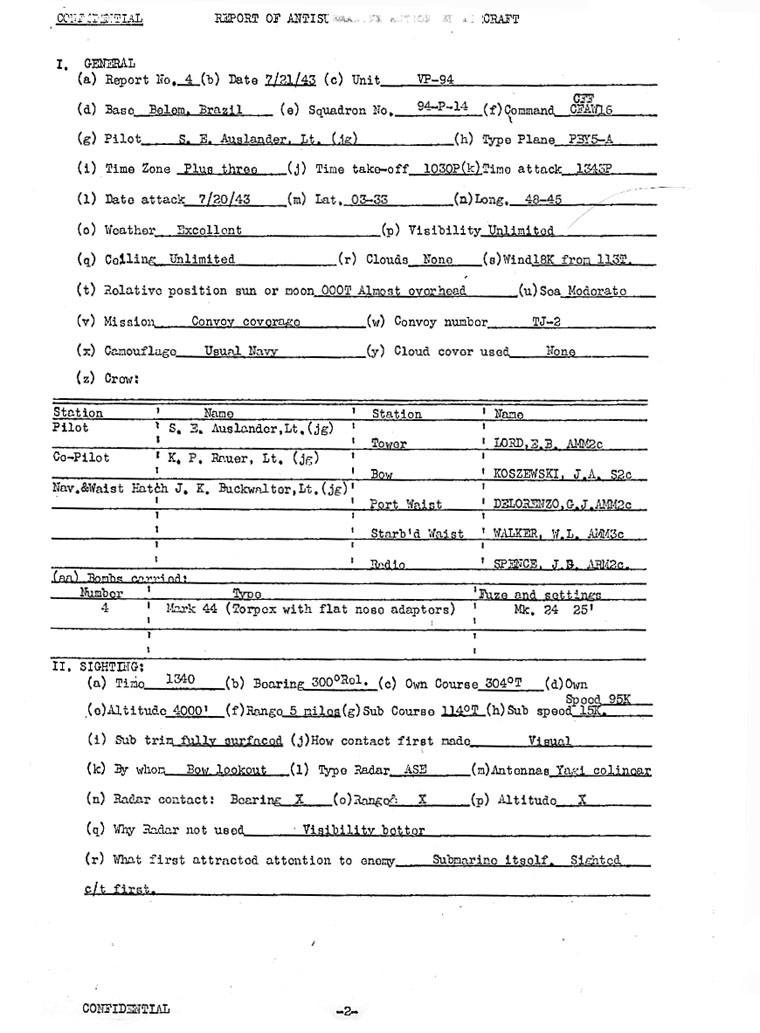

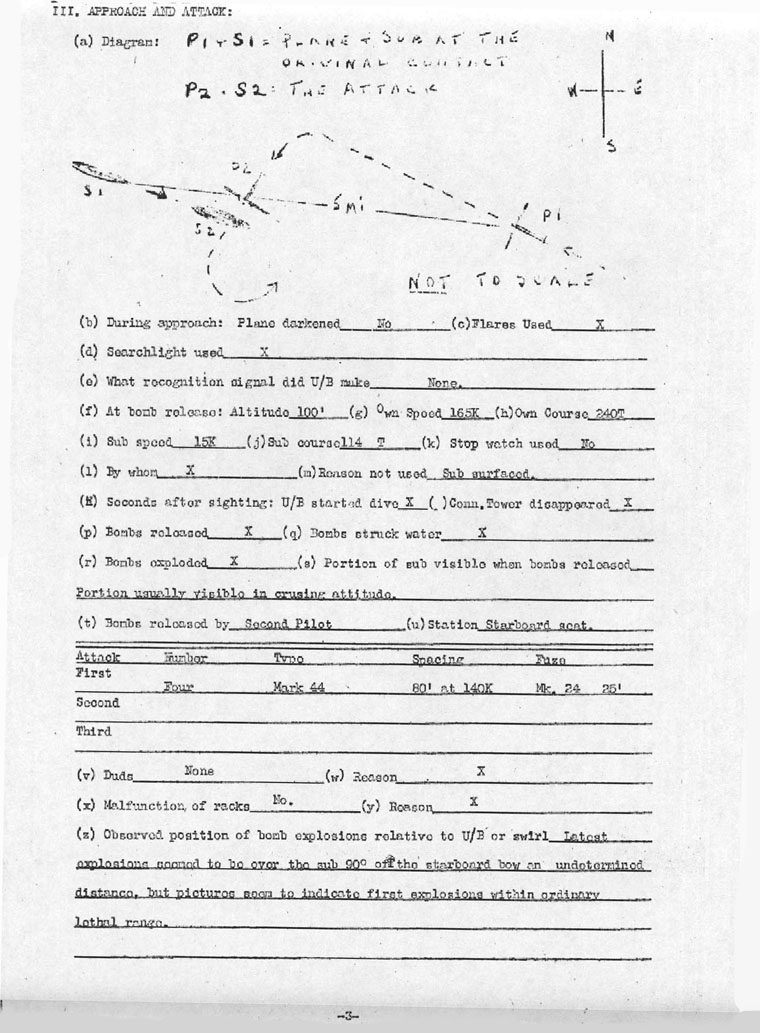
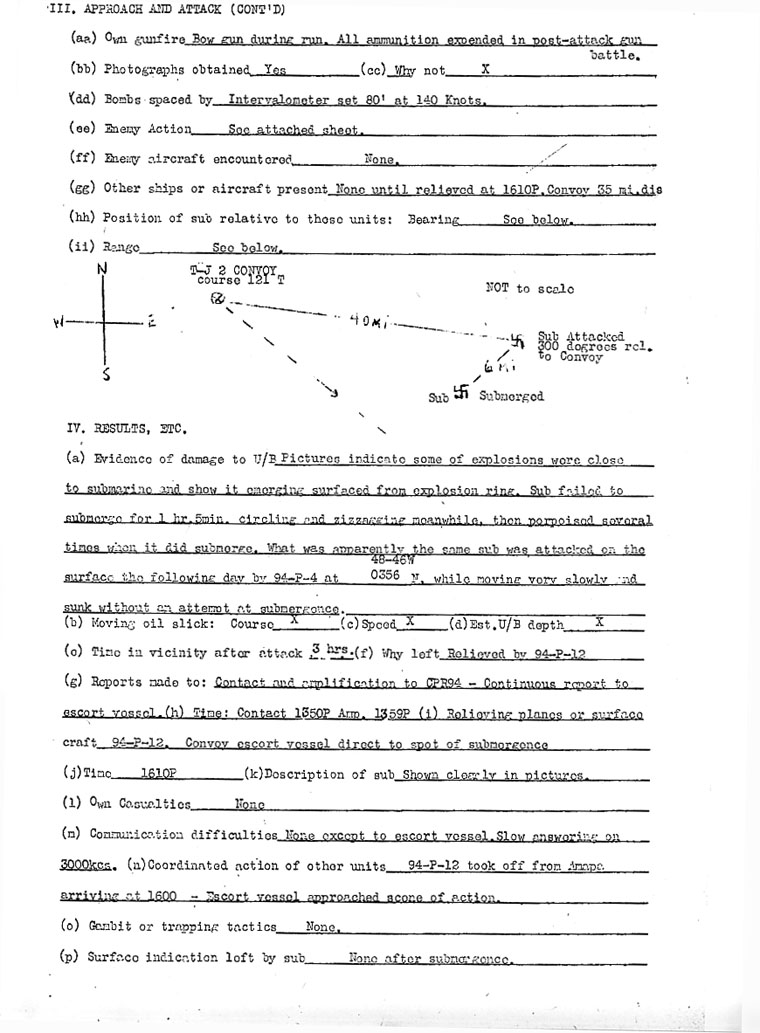
| CONFIDENTIAL | ||
| III. APPROACH and ATTACK. | ||
| (ee) Enemy Action - The submarine opened fire almost immediately after the sighting, and the general observation was that the air was filled with bursts of smoke, some white and some dark, not very large, probably about two or three feet in diameter, but easily seen. Many tracers were also visible. One of the pilots received the impression that some of the bursts and tracers were from the same shell, although this was a necessarily vague observation. | ||
| The submarine did not change course or attempt any evasive action whatever, prior to the drop, although it may have increased speed somewhat. Immediately after the drop, the submarine started to zigzag, as the pictures indicate, and then it started to circle, presenting its beam to the plane throughout the running gun battle that followed. | ||
| All during the hour long battle the submarine continued to fire at the plane. While the plane was in close, the fire was heavy and continuous, the barrage effect being accentuated, the impression received by the pilot being that of receiving fire from multiple guns. When the plane reached a greater altitude, approaching 5,000', and a greater distance from the sub, the firing from the U/B was intermittent, there being only a few rounds fired every two or three minutes. | ||
| No apparent attempt at submergence was made until after the plane started away to lead the approaching escort vessel to the submarine, and then only after the plane was at a distance too great to make another attack before submergence could be completed. | ||
| It would seem that the submarine's actions in both this attack, and in the attack of 94-P-10 on July 9, 1943 might indicate that the U/B's have concluded that remaining on the surface while there is danger of attack is safer than attempting to submerge and being attacked while so doing. The circling during the time the U/B is subject to gunfire would seem to be a defensive maneuver, which might give some indication as to the direction in which its guns can bear. | ||
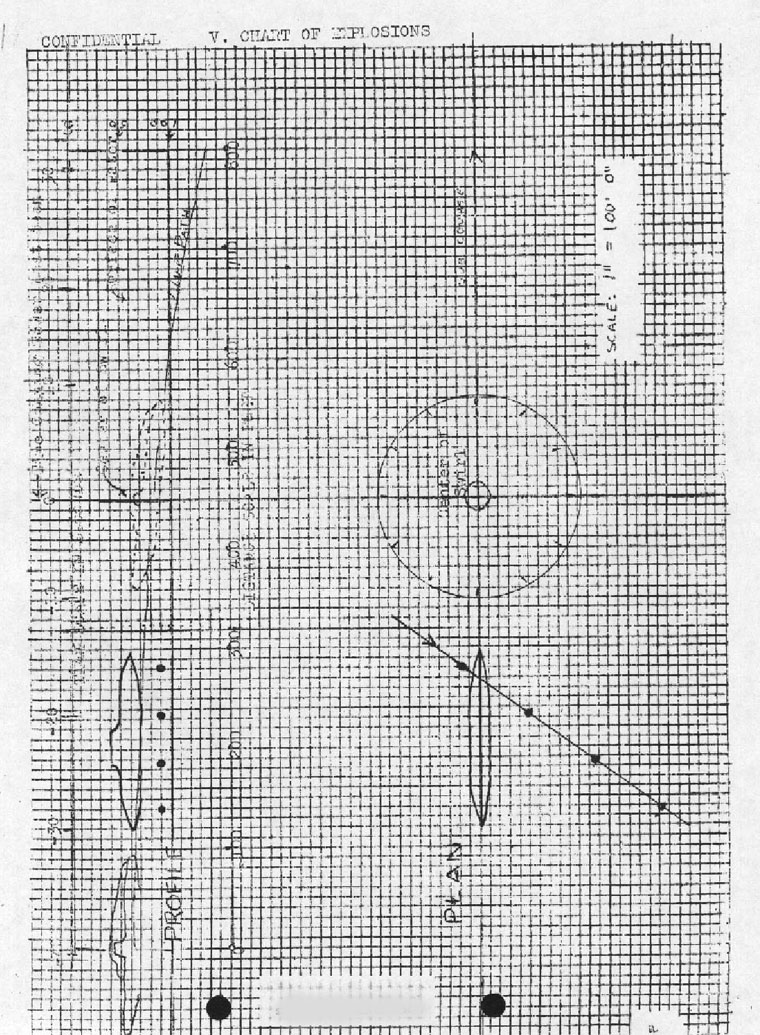
CONFIDENTIAL |
||
NARRATIVE |
||
On July 20, 94-P-14, PPC Lt. (jg) Auslander took off at 10:30 P from Amapa Brazil to relieve 94-P-8 on TJ-2. |
||
The convoy was sighted at 1235 on course 1210T when the plane was at an altitude of 1800'. The pilot circled the escort leader, obtained the 1200P position of the convoy by blinker, and then climbed to 4000' while circling the convoy. |
||
At 1259 the plane departed on course 1100(T) on a sweep ahead of the convoy. During this sweep, the 1200P position was sent to the base. At 1328 course was changed to 0540T. At 1333 course was changed to 3040(T) to head back towards the convoy. At 1341 the bow lookout reported a ship to port, ten o'clock, five miles. The position was 03-33N, 48-45W. |
||
Lt. (jg) Auslander recognized it as an enemy submarine on course about 1140T, blew the warning horn, disengaged the automatic pilot, and signaled the tower to put the mixture control into auto-rich. The plane was nosed over and a turn to port started. Meanwhile, the co-pilot turned the bombing switch on an picked up the "pickle". |
||
As the run was started, the air was filled with bursts of smoke and tracers. During the run, the navigator ran back to the blister for the camera, and the radioman started to send out the contact report. The throttles were pulled back, and the plane lost altitude and picked up speed as the pilot executed several skidding turns in order to evade the gunfire. About a mile away from the sub, the pilot leveled off briefly and then pushed over again on course 2400. The co-pilot, on signal from the first pilot, made the drop at about 100' and 165 IAS. |
||
The pilot held his course briefly after pulling out, and then made a sharp turn to port. According to the Navigator, who was in the starboard blister, the drop was over, the bombs landing 30' to 50' over the submarine on the starboard side and slightly ahead. The pilot pulled up and the crew continued firing on the sub from blister guns and the bow gun. On scene of action voice frequency, the pilot called the escort vessels of the convoy which were close by, and at the same time the radioman was instructed to send MO's on 414Kcs. |
||
| The escort commander finally answered and was advised of the attack and position, and that the plane was sending MO's on frequency. Meanwhile, the plane was still firing on the submarine. Circling to port to give the port gun a chance to fire, and then to starboard for the starboard gun. The submarine continued to circle and return the fire. After about forty minutes he started on a zig-zag course, a very erratic one. At this time the plane had reached an altitude of 5000', visibility was unlimited; there were no clouds. The pilot felt that the escort would be able to see the plane at that altitude. A large wake heading for the plane's position was observed; so course was changed toward the escort. He was approximately 20 miles away making good speed. The after station kept watching the submarine which was still surfaced. When the plane was half way between the sub and escort vessel, the after station reported submarine was starting to submerge. The pilot immediately turned and dove on it with a green fluorescein dye marker ready to mark the spot. The U/B seemed to have difficulty submerging, as it seemed to go under, come up, go under, and come up again. It finally submerged at 1445P on course 1140T, and the marker was dropped. The plane, circling the sport, notified the escort vessels that the sub had submerged. The escort apparently discontinued his course towards the plane. | ||
| The pilot started to fly a 20 miles square around the point at which the sub submerged, and completed the circuit once. At 1610P P-14 was relieved by 94-P-12, and after indicating the spot where the dye marker was still clearly visible, the plane departed for Belem at about 1700P. | ||
- - - - - - - - - - - - - - - - - - - - |
||
CONFIDENTIAL |
||||||||||||||||||||||||||||||||||||||||||||||||||||||||||||||||||||||||||||||||||||||||||||||||||||||||||||||||||||||||||||||||||||||||||||||||||||||||||||||
CHRONOLOGY OF OPERATIONAL ACTIVITIES AT VP-94 BELEM, BRAZIL JULY 19 - JULY 21, 1943. |
||||||||||||||||||||||||||||||||||||||||||||||||||||||||||||||||||||||||||||||||||||||||||||||||||||||||||||||||||||||||||||||||||||||||||||||||||||||||||||||
THE DATE GROUPS OF MESSAGES (M) ARE ZEBRA TIME; OPERTIONAL FLIGHTS (O) ARE PETER TIME |
||||||||||||||||||||||||||||||||||||||||||||||||||||||||||||||||||||||||||||||||||||||||||||||||||||||||||||||||||||||||||||||||||||||||||||||||||||||||||||||
|
||||||||||||||||||||||||||||||||||||||||||||||||||||||||||||||||||||||||||||||||||||||||||||||||||||||||||||||||||||||||||||||||||||||||||||||||||||||||||||||
- 1 - |
||||||||||||||||||||||||||||||||||||||||||||||||||||||||||||||||||||||||||||||||||||||||||||||||||||||||||||||||||||||||||||||||||||||||||||||||||||||||||||||
CONFIDENTIAL |
||||||||||||||||||||||||||||||||||||||||||||||||||||||||||||||||||||||||||||||||||||||||||
CHRONOLOGY OF OPERATIONAL ACTIVITIES AT VP-94 BELEM, BRAZIL JULY 19 - JULY 21, 1943. |
||||||||||||||||||||||||||||||||||||||||||||||||||||||||||||||||||||||||||||||||||||||||||
THE DATE GROUPS OF MESSAGES (M) ARE ZEBRA TIME; OPERTIONAL FLIGHTS (O) ARE PETER TIME |
||||||||||||||||||||||||||||||||||||||||||||||||||||||||||||||||||||||||||||||||||||||||||
|
||||||||||||||||||||||||||||||||||||||||||||||||||||||||||||||||||||||||||||||||||||||||||
(COVERAGE ON JT-1 WAS FINISHED 1200P 21st AND COVERAGE ON TJ-22 WAS FINISHED WITHOUT INCIDENT ON JULY 23rd.) |
||||||||||||||||||||||||||||||||||||||||||||||||||||||||||||||||||||||||||||||||||||||||||
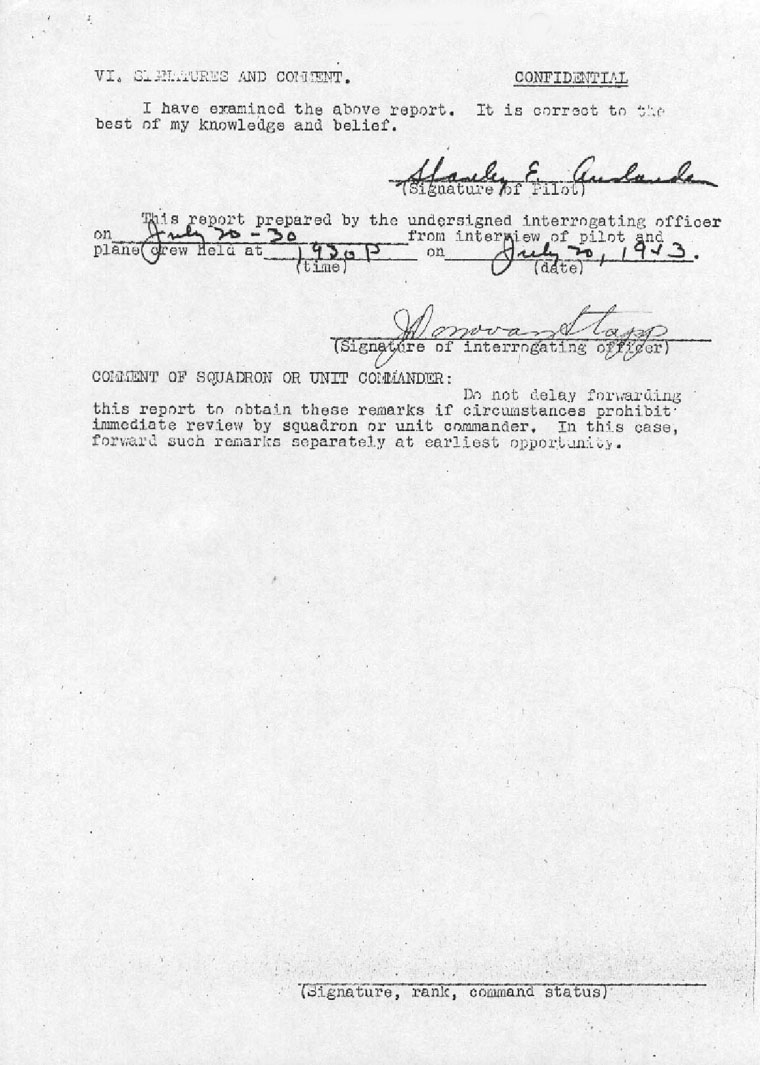
C O N F I D E N T I A L |
||
COMMANDING OFFICER'S COMMENTS ON ATTACK OF 94-P-14, JULY 20, 1943. |
||
1. This attack was well planned and apparently well executed. The crew that observed the bomb explosions think that the bombs fell over, but the pictures of the attack indicate a perfect straddle. Undoubtedly the submarine was damaged, but for some reason did not receive a lethal hit. The following day 94-P-4 attacked a submarine on the surface in the same location, making a successful run. This was probably the same submarine damaged in Peter 14's attack the day before and unable to travel far or fast during the night. |
||
2. This plane expended all its ammunition strafing the submarine after the drop. In an hour's time the plane received but one hit by an explosive shrapnel shell even though it was close within gun range of the submarine most of the time. |
||
3. According to the plane pilot's observations, the escort vessel that was dispatched from the convoy to contact the submarine returned to the convoy when advised by the plane that the submarine had submerged, even though he was only approximately 15 miles away. It seems strange that an escort vessel would disregard such an opportunity to bag a submarine. |
||
| |
||
| J. B. TIBBETS, | ||
| Lieut. Comdr. USN, | ||
| Commanding. | ||
C O N F I D E N T I A L |
||||||||||||||||||||||||||||||||||||||
COMMANDING OFFICER'S COMMENTS ON ATTACKS IN GENERAL |
||||||||||||||||||||||||||||||||||||||
1. Comments on each separate attack have been previously submitted. The following comments will be based in general on the following sightings and attacks as a group: |
||||||||||||||||||||||||||||||||||||||
|
||||||||||||||||||||||||||||||||||||||
2. All of those attacks were characterized by similar tactics on the part of the submarine--the definite decision to stay on the surface and shoot it out. All six attacks were made on fully surfaced submarines. Four of the six attacks met enemy fire. Of the remaining two attacks, one was apparently a complete surprise and the other was made during darkness. |
||||||||||||||||||||||||||||||||||||||
3. Undoubtedly the submarines have received definite orders to remain surfaced and use their guns. In the past 15 days the submarines, using these tactics, have slightly damaged four planes--none completely out of commission--killed one officer pilot, and wounded one radioman. In return, during the same period, these tactics have afforded the planes the opportunity to make nine sightings, six of which resulted in attacks giving three possible sinkings. Our reaction is that the decision to stay surfaced and shoot it out is hard on submarines. We hope that the submarines maintain their present tactics. |
||||||||||||||||||||||||||||||||||||||
4. The enemy fire encountered in these attacks is of a different type than my knowledge had led me to expect. There was little or no anti-aircraft fire from guns approximating 4" or 5" size. No large black or white bursts were seen. Tracers from smaller caliber guns were seen, and in each case small explosive bursts were seen well in front of the plane as well as close around the plane at various distances during the approach. Three planes were hit by bullets which exploded on impact about one foot after passing through the metal skin or fabric of the plane. After talking to the plane personnel, it is my opinion that the bullets used are slightly larger than .50 cal., come with or without tracer, explode slightly after contact, and also have a variable time fused explosion. Either the shells are filled with small shrapnel or else the body breaks up into shrapnel. I believe that these bullets can be set to explode at a given distance thus giving a barrage effect for an incoming plane. Once the plane reaches the barrage, the bullets then will explode upon contact. Probably the submarines have two of these rapid fire guns, one set for a close barrage, and the other to reach way out for the attacking plane before it reaches the barrage. These guns are mounted in or near the conning tower. The pictures of submarines in these attacks show a new type of submarine with a shielded gun aft of the conning tower. Evidently this type of submarine has orders to use its new armament against airplanes on the surface. |
||||||||||||||||||||||||||||||||||||||
5. The three attacks which resulted in probable sinkings were all characterized by the same post-explosion action. The submarines were fully surfaced with personnel on deck at the time of the drop. The spray from the explosion completely hid the submarine. When the spray subsided the submarine was in one case completely gone, and in the other two cases only a small section of the bow was visible going straight down fast. In no case did more than two seconds elapse from the time of the explosion to the time of the submarine's disappearance. Either the submarines have a new submergence technique, or else their skins are thinner. |
||||||||||||||||||||||||||||||||||||||
C O N F I D E N T I A L |
||
Page 2. |
||
COMMANDING OFFICER'S COMMENTS ON ATTACKS IN GENERAL (CONT'D) |
||
6. All but three of the nine sightings in the past two weeks have been made by the bow lookout who stands erect, head exposed, wearing helmet and goggles. Of the remaining three sightings, one was made by a pilot and the other two by radar at night. The lookout assignment in the planes of this squadron is bow lookout, pilots and tower. Any extra lookouts are placed in the blisters, but they are secondary and optional. The bow lookout is mandatory. |
||
7. It has been proved essential to have the planes on station for escort duty well before daylight when night coverage has not been in effect, and also to be certain that the plane remains on duty until well after dark. While this has certainly for some time been the ordered in existence for daylight coverage, the practice in general has been to arrive about daylight and leave about dark, more or less. |
||
8. It is interesting to note that planes on convoy coverage have made six sightings which resulted in three attacks and one probable sinking. Sweeps gave two sightings which resulted in two attacks with one probable sinking. A plane in transit to a convoy made a sighting which resulted in an attack and a probable sinking. It would seem from this that convoy coverage was more productive of sighting than sweeps. In most cases, however, the escorting plane found the submarine at a greater distance from the convoy than his escort plan normally would permit. If the planes had kept to the regular escort plan the entire time, the submarines would undoubtedly have shadowed the convoy during the day and caught up at night. |
||
9. The submarine commanders must have excellent intelligence. Their concentrations were not only on the convoy routes but were also timed to be in the area where two oppositely bound convoys were due to pass. Apparently the subs lie quite a distance offshore, moving in only when the convoys approach. |
||
10. Convoy coverage is productive of submarine contacts only, naturally, when the convoy passes through submarine areas. Definitely, the planes should always go to the submarines. When the submarines head for the convoys, the planes should proceed them. When the submarines leave the convoys for other areas, the planes should follow them. |
||
11. The submarines undoubtedly have figured out the weaknesses of our present system of convoy escort plans and have commenced tactics to take advantage of those weaknesses. In these waters, for instance, the visibility is unusually good in good weather. The present escort plane is designed to prevent the submarine from closing in to attack the convoy while coverage is in effect. It also would prevent a submarine from coming in close enough on the surface, to sight and track the convoy from ahead or from the sides. It is not designed, however, to prevent the submarine from following the convoy during the day, tracking the smoke sightings from a distance astern greater than the escort plan carries the plane, and then overtaking the convoy during the night. Visibility of the convoy from the submarine is just as good from astern as from ahead, and the escort plan allows the submarine to come closer astern than ahead of the convoy. The submarine is content to trail astern during the day and attack during the night. Therefore a new escort plan should be designed not only to prevent a submarine from attacking during the escorting, but also to prevent the submarine from tracking during the escorting. This command is compromising at present by using the escort plan during the day until four hours prior to dark and sweeping astern, to the sides, ahead and then lastly astern again just prior to dark. In my opinion it is better to take a chance on the submarine attacking during the late afternoon and sweep to prevent him tracking for a sure attack during the night. When a convoy is passing through a threatened area and planes are available, the escort plan is continued till dark while a second plane sweeps at a greater distance from the convoy. |
||
C O N F I D E N T I A L |
||
Page 3. |
||
COMMANDING OFFICER'S COMMENTS ON ATTACKS IN GENERAL (CONT'D) |
||
| 12. Airplane deficiencies were apparent in these attacks. Several of the attacks were made at speeds close to 200 knots. At this speed the bow gun becomes unmanageable because of the wind on the gun and gunner. If the bow gunner can shoot, the maximum number of rounds available on these planes is 100, the capacity of each pan. The entire armor installation on these planes is designed for protection from the rear. With the impact-shrapnel type of bullet the submarines are using, enemy fire from ahead into rear armor means certain shrapnel explosions in the exact area the armor is designed to protect. | ||
| 13. The radar carried by these planes may be detected by the submarines. An improved type of radar is available. Our planes are now rotating for overhaul at Norfolk. So far they have all returned with the same radar that they took up North. | ||
| |
||
| J. B. TIBBETS, | ||
| Lieut. Comdr. USN, | ||
| Commanding. | ||